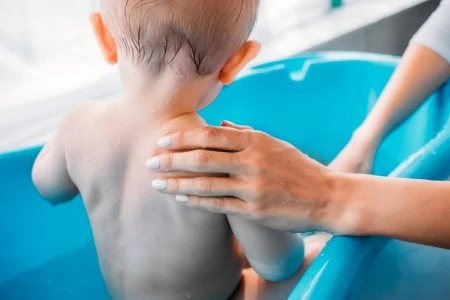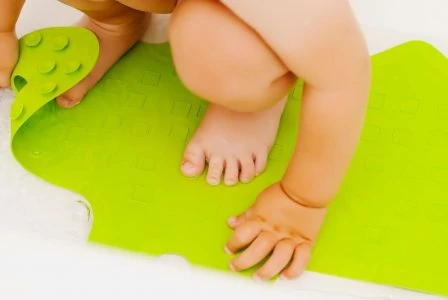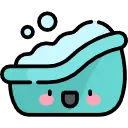Most new parents find the first bath intimidating. And it’s no wonder. A newborn is tiny, fragile, and wiggly, so you want to ensure they are safe at bathtime.
Between all of us moms on the team at Mom Loves Best, we’ve bathed a LOT of babies! We’ve gained confidence in the process and are here to share our tips.
We’ll give you the play-by-play on how to bathe your baby, and we’ll answer the most common questions about the process so you can bathe your little one with confidence and enjoy those sweet bonding moments.
Key Takeaways
- During the first weeks, give your baby a sponge bath to keep the umbilical cord stump dry and promote healing.
- Gather all necessary supplies before starting, including mild baby-safe soap, a large bowl or basin, warm water, washcloths, and a soft blanket or changing pad.
- Gently clean your baby’s face, neck, chest, and diaper area, using a separate cloth for each area and avoiding soap in the genital area.
- When the umbilical cord stump falls off and heals, you can transition to tub baths, making sure to keep the baby warm and supported throughout the process.
The First Weeks
A good old sponge bath is the best way to clean your baby during the first few weeks. Your baby will likely still have their umbilical cord stump, which we need to care for the best we can.
While this area is healing, keep it as dry as possible. That means no tub bath if you can avoid it. Even if you dry it after a tub bath, it may remain moist, prolonging the healing process.
Take Note
How to Give Your Baby a Sponge Bath
Make sure you have everything you need before getting started. You don’t want to be standing with a naked baby while trying to grab things out of your reach.
Here’s a list of the supplies you’ll need:
- Mild, baby-safe soap and shampoo (optional).
- Large bowl or basin to hold water.
- Clean clothes and a diaper.
- Warm water.
- Baby lotion.
- A changing pad or a soft blanket.
- Two or three washcloths.
- Cotton balls.
- Plastic cup.
- Two towels, preferably one with a hood.
1. Prepare the Sponge Bath
Begin by placing the changing pad or soft blanket on a flat, warm surface. Some parents like to use the changing table; others prefer a bed or even the kitchen counter.
Always keep a hand on your baby! Even though newborns don’t roll, they can still wiggle themselves into unwanted situations.
You need one cloth to start wiping your baby with clean water. If you choose to use soap, you will need a separate one. Finally, you need another for the diaper area.
2. Undress Your Baby Carefully
Take off everything except the diaper. Leave this until the end, as we all know how unpredictable babies can be with their bodily functions.
Wrap your baby in a soft towel and communicate softly with them. Tell them what you’re doing and how much you love those chubby thighs.
3. Wipe Your Baby Gently
Dip the first cloth in the water, and wring out the excess. It shouldn’t be dripping wet, just damp.
Start by wiping your baby’s face. Gently remove any crust from the eye area, and clean around the mouth and chin to get rid of dried milk. Move down to the neck and carefully wipe all around, ensuring you get between those folds in your baby’s multiple chubby chins.
Some prefer to use cotton balls to clean around their baby’s eyes. If you do, remember to squeeze out excess water, leaving the cotton soft but not too wet.
Uncover the upper part of the chest and clean it, remembering to dip the cloth in the warm water regularly.
If you want to use a mild soap, first wet the cloth, then add a tiny amount of soap. Sponge the area, and repeat with a clean, moist cloth to remove any residue.
Remember
Check fingers and toes for any hair wrapped around. These can cut off blood flow or harm your baby’s sensitive skin. Also, check your baby’s neck for loose hairs.
4. Remove the Diaper
Once your baby is clean, it’s time to uncover the diaper area. It is crucial to clean this area carefully. Diaper rashes often occur due to undiscovered poop in the tiny folds of the skin.
Wipe all folds and cracks. You shouldn’t use soap in the genital area. If you have a circumcised boy, avoid using soap until the area is completely healed.
5. To Shampoo — Or Not?
It’s not necessary to shampoo a newborn’s hair, even though some babies are born with a full head of hair.
If you choose to use shampoo, lay your baby close to the bowl or basin. Gently lift their head over the bowl, carrying them in a football hold across your hand and lower arm. Your hand should support their neck.
Use the plastic cup or your free hand to pour small amounts of water over your baby’s head. Pour the water from front to back, ensuring it doesn’t spill down their face.
Apply a small drop of shampoo and softly lather it into the hair; never rub hard! Use the cup or your hand to rinse out the shampoo afterward. Make sure no soapy water goes over your baby’s face.
6. Dry Your Baby Carefully
Once you’ve finished the sponge bath, wrap your bundle of joy in the hooded towel. Lightly pat your baby dry.
Newborns sometimes have a significant amount of dead skin, but don’t try to remove it by rubbing with a towel. Instead, use a small amount of baby lotion on these areas. This keeps the skin moist while it slowly sheds the excess skin.
7. Care for the Cord Stump
With a clean, damp washcloth, carefully pat the area around the cord. Gently lift the clip to reach all sides, never pulling or tugging on it.
In the summer, dress your baby in a diaper and loose T-shirt. This ensures nothing is pulling at the cord. It also allows airflow, keeping the area dry and possibly accelerating the stump’s removal (2).
How Often Should You Bathe Your Baby?
Giving your baby a sponge bath every two or three days is more than enough. However, wipe some areas, such as the face and hands frequently. Clean the diaper area at every change.
Bathing Your Baby in a Tub
Once the umbilical cord stump is off and the area has healed, you can begin tub baths.
Bathing your baby in a tub is not the same for all parents. Some babies love the feel of the water, while others will scream until you take them out.
You will need a few items when bathing your baby. As with a sponge bath, gather everything before you start.
Pro Tip
Here’s what you need:
- A baby bathtub, washbasin, or sink.
- Two towels.
- A washcloth or sponge.
- A flat, secure location.
- Soap and shampoo.
- Plastic cup.
- Bowl or basin with clean water.
1. Preparing the Bath
Use a plastic tub or sink large enough to hold your baby. If the tub doesn’t have a non-slip surface, line it with a clean towel. This prevents your baby from sliding around, softens any edges, and protects them from the cold surfaces.
Ensure everything you need is within reach. Add a couple of inches of water to the tub.
2. Getting Your Baby Into the Tub
Undress your little bundle with care. Remember to remove all other clothing first, leaving the diaper until last. Support your baby’s head and neck with one arm, and use the other to guide their feet into the water.
Go slowly; you don’t want to surprise your baby. Support your baby’s head and neck the whole time with a tub support or your hand.
3. Body Wash
Once they’re in the tub, use your hand or a plastic cup to slowly pour warm water over their body. Gently wipe with a washcloth. Maintain eye contact, speak softly and smile to assure them everything is fine.
If you want to use a mild soap (optional), wet a sponge or cloth. Add a small amount of soap and begin to lather your baby carefully. Get into all those lovely, hidden folds, especially in the underarm, neck, and diaper area.
Use a clean, moist cloth or cotton balls to wipe your baby’s face. Never pour water onto the face, as this will startle your baby.
4. Shampoo Time
Support your baby’s head and neck while slowly pouring water over their hair. Try to sweep off excess water and prevent it from running down their face. If this is not possible, put a clean washcloth on your baby’s forehead, ensuring their eyes remain uncovered.
Use a small drop of shampoo, and lather the hair. When rinsing out the shampoo, use the same technique of pouring water and sweeping. Even though baby shampoo is mild and safe, it can still be uncomfortable if it gets in your baby’s eyes.
5. Rinse Away the Bubbles
Before taking your baby out of the tub, use the clean water from the bowl or basin to rinse off any soap. You can use the plastic cup or a clean washcloth to do this.
6. After-Bath Care
As soon as you’ve finished, wrap your baby in a warm towel. Place them on a flat surface or changing table.
Pat them dry, and apply lotion or oil to prevent their skin from drying out.
Help Your Baby Enjoy Bathtime
Bathtime should be relaxing and enjoyable. But we know this is not always the case. If your baby loves bathtime, you’re one of the lucky ones.
If not, we have a few tips to make bathtime a happy time:
- Ensure the temperature is right: If your baby is crying, the water may be too hot or cold.
- Is your baby fully rested? A tired baby is often a fussy baby.
- Try different positions: Some babies prefer to sit up in the bath.
- Bring a toy or two: Keep your baby entertained.
- Interact with your baby: Talk them through everything so they know bathtime is fun (3).




















